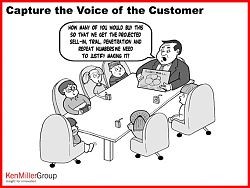Operational Definitions: Not a Perfunctory Exercise
We have a colleague whose favourite words these days is “perfunctory”, and he uses it frequently enough that I looked up the definition just to be sure I knew what it meant.
per-func-to-ry adjective \pər-ˈfəŋ(k)-t(ə-)rē\
- characterized by routine or superficiality
- lacking in interest or enthusiasm
That little exercise reminded me of how important it is to have common definitions at work. Never mind the embarassment of using a word incorrectly, which we’ve all done on occasion. (Well I have, anyway…) It’s about speaking the same language in the office, and avoiding any potential for misinterpretation and mistake.
My Definition is This (Bonus earworm for those who know that tune, for those who don’t, click here )
One of the things we are working on right now is a review of a PMO (Project Management Office) function in a large public sector organization. As part of any review, we conduct a number of interviews with various employees at all levels of the organization. And, as always, we find that people are working with differing levels of understanding of key operational terms, and that this is creating some confusion with respect to roles, responsibilities, and key outcomes.
Here’s a good example: what does performance management mean to you? Is it related to the work output and behaviours of an individual employee, and the ability of a manager to influence it positively?
No? Oh, well perhaps you feel it’s the use of key performance indicators to ensure that an organization meets its goals and targets in a timely manner.
Wait, what? You think it’s both?
If you look it up, even Wikipedia gives several definitions:
Performance management (PM) includes activities which ensure that goals are consistently being met in an effective and efficient manner. Performance management can focus on the performance of an organization, a department, employee, or even the processes to build a product of service, as well as many other areas.
PM is also known as a process by which organizations align their resources, systems and employees to strategic objectives and priorities.
Performance management as referenced on this page in a broad term coined by Dr. Aubrey Daniels in the late 1970s to describe a technology (i.e. science imbedded in applications methods) for managing both behavior and results, two critical elements of what is known as performance.
If you’re working on a culture shift in your organization, then a great exercise involves getting groups of people together in a room and having work in small groups to define key terms. For instance, for a PMO conversation, you might have people define: Project, Charter, Project Manager, Process Owner, Project Sponsor, Communication Plan, Risk Mitigation Plan, etc. Here’s the trick: there’s usually no right answer. Just pick the one that works for most people, and stick with it! If everyone is speaking the same language, you’ll save so much confusion and time.
And there’s nothing perfunctory about that.
Give us a shout via Twitter @whiteboardcons using #betterfastercheaper or email us at info@whiteboardconsulting.ca/staging.
Until next week,
Ruth.





 In addition, our teaching is based on the Howard Gardner’s theory of “multiple intelligences”, which states that there are several types of learning styles (e.g. kinaesthetic, logical, intra-personal, visual/spatial, linguistic, interpersonal, etc). Our style is to ensure that each type of learner will find some portion of our agenda that resonates with them. By doing this, we reach every single student.
In addition, our teaching is based on the Howard Gardner’s theory of “multiple intelligences”, which states that there are several types of learning styles (e.g. kinaesthetic, logical, intra-personal, visual/spatial, linguistic, interpersonal, etc). Our style is to ensure that each type of learner will find some portion of our agenda that resonates with them. By doing this, we reach every single student.
 PI-301: Connect the Dots: Why Data is Important
PI-301: Connect the Dots: Why Data is Important






